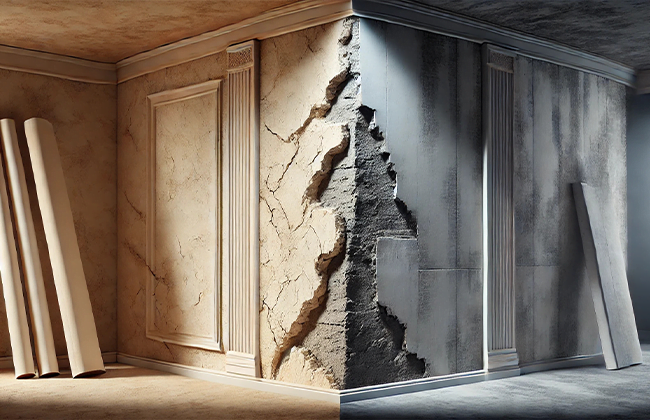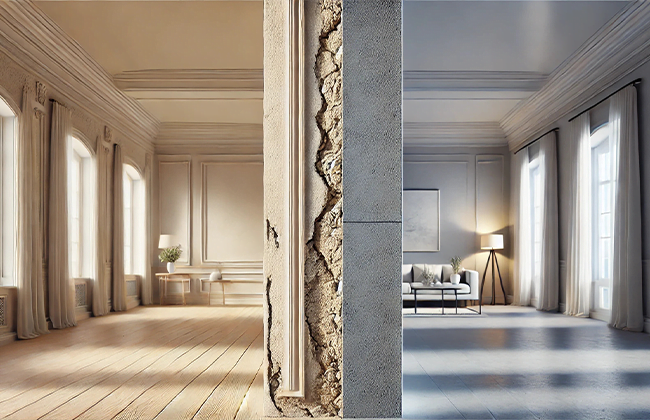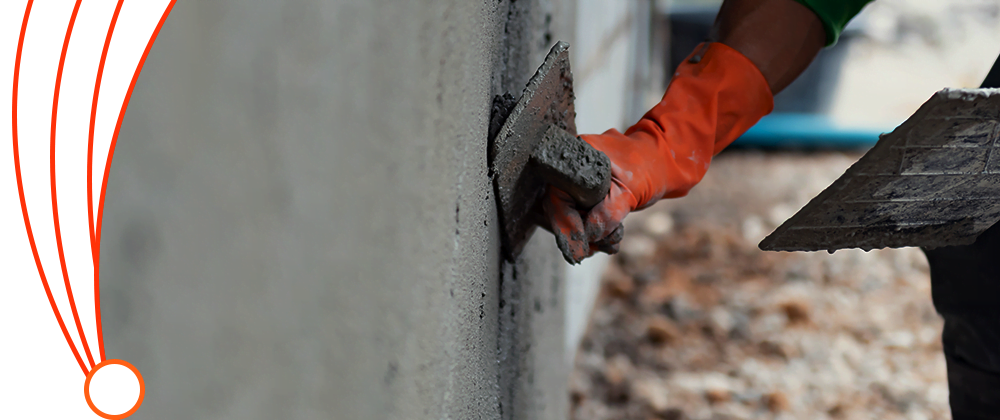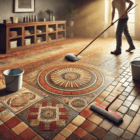When considering home improvements or repairs, choosing between plaster and drywall is a crucial decision. Both materials offer unique benefits, but understanding their differences can help you make an informed choice. Plaster is renowned for its durability and aesthetic versatility, while drywall is celebrated for its cost-effectiveness and ease of installation. Whether you’re renovating an old building or finishing a new construction, knowing the specifics of plaster vs. drywall will guide your decision-making process.
Table of Contents
Overview of Plaster and Drywall
When you’re standing in front of a freshly built or renovated home, have you ever paused to wonder what lies beneath the paint and finishes in the Plaster vs Drywall comparison?
It’s not just about colors and textures; the very walls themselves have stories made of plaster or drywall. These materials, though seemingly mundane, play crucial roles in the structural integrity, aesthetic appeal, and environmental control of our living spaces in the ongoing Plaster vs Drywall debate.
What is Plaster?
Plaster, a traditional building material, has been used to coat walls and ceilings for millennia. This time-tested method involves applying several layers of a mixture, typically consisting of sand, lime, and cement, or more modern materials like gypsum. The result?
A hard, durable surface that can be smoothed to a high sheen or textured for decorative effects. Here’s a closer look at its variations:
- Gypsum Plaster: Renowned for its quick setting time and smooth finish, gypsum plaster is a favorite for interior walls because it minimizes the risk of cracks.
- Lime Plaster: With its high plasticity, lime plaster is excellent for creating intricate moldings in heritage restorations.
- Cement Plaster: Highly resistant to weather elements, making it an ideal choice for exterior walls and damp environments.
The art of plastering requires skilled hands. It’s not just about throwing up a mixture and hoping it sticks; it’s about layering and crafting a surface that stands the test of time, blending seamlessly with the architectural aesthetics.
What is Drywall?
Contrasting the historical depth of plaster, drywall represents the innovation of modern construction. Composed of a gypsum plaster core sandwiched between two layers of heavy paper, drywall panels are a quick-install solution that revolutionized the building industry. Drywall comes in various types to meet diverse needs:
- Standard Drywall: Widely used due to its ease of installation and cost-effectiveness. It’s the unsung hero of quick renovations and builds.
- Moisture-Resistant Drywall: Also known as green board, its water-resistant properties make it suitable for use in kitchens and bathrooms.
- Fire-Resistant Drywall: Enhanced with fire-retardant additives, this type of drywall is designed to slow the spread of flames, providing additional safety in residential and commercial buildings.
The popularity of drywall lies in its simplicity. It has allowed for faster build times, which is crucial in today’s fast-paced construction schedules. Moreover, its versatility makes it adaptable to various architectural styles and preferences.
By understanding both plaster and drywall, homeowners and builders can make informed decisions based on durability, cost, and aesthetic desire. Now, let’s delve deeper into how each of these materials is installed, comparing the methodologies and intricacies involved.
Installation Process
Choosing the right materials and installation methods for your walls isn’t just a technical decision—it’s a personal one too. Whether it’s the timeless allure of plaster or the practicality of drywall, understanding the installation process can make all the difference in achieving the desired ambiance and functionality of your space.
Plaster Installation
Plastering is a time-honored technique that blends art with construction. Here’s what goes into creating those impeccably smooth walls:
- Preparation is Key: Before anything else, the walls must be prepped. This means ensuring they are not only clean but also slightly roughened up to help the plaster adhere better. Sometimes, a bonding agent is also applied for better adhesion.
- The Art of Mixing: Mixing plaster isn’t just about stirring water into powder. It’s about getting the consistency just right—too thick might make it hard to work with, and too thin might weaken the structure. Professionals often use a power mixer to ensure uniformity.
- Layer by Layer: The application starts with a scratch coat—thick and rough, it’s embedded into the wall surface with firm strokes of a trowel. This layer is then scratched with a comb to create a textured base that will grip the next layer.
- Building Up: Subsequent layers are thinner, each meticulously applied to smooth out the texture from the previous one. It’s a game of patience and precision, where each layer is allowed to dry just enough before the next is applied.
- The Final Touch: The final layer is where the magic happens. This is where skilled plasterers showcase their craftsmanship, smoothing the plaster to a glass-like finish or creating textured patterns, depending on the aesthetic desires of the homeowner.
Drywall Installation
Drywall might not have the romantic history of plaster, but its installation process has its own set of perks—speed, simplicity, and satisfaction:
- Precision Cutting: Measuring and cutting drywall to exact dimensions is crucial. A straightedge and a sharp knife are the main tools, ensuring that each panel fits perfectly without gaps.
- Fixing in Place: Lifting and securing the drywall panels can be a workout! They’re fixed onto the framework of the building using screws, spaced carefully to avoid any sagging or warping over time.
- Seamless Seams: The real trick in drywall installation lies in the taping and mudding. Drywall tape is applied over the joints, and then joint compound is used to cover the tape and screw heads. This is smoothed over several applications, each sanded down once dry to ensure a seamless surface.
- Sanding to Perfection: The final step involves sanding down the dried mud to a silky finish. It’s messy, but it’s also where the wall starts to really come together, ready for painting or wallpapering.
Installing plaster or drywall effectively transforms a structure into a home, with each method providing unique benefits. While plaster offers a robust, high-quality finish, drywall allows for quick and flexible installation, making it ideal for various modern construction projects.
As we delve into the nuances of these materials, it becomes clear that understanding the full scope of their installation helps in making informed choices. Next, we will explore the economic implications of using plaster versus drywall, providing a detailed comparison of the costs associated with each option. This analysis will assist you in determining which material is most suitable for your project, considering both your budget and the desired longevity of your wall finishes.
Cost Comparison
Budgeting is a fundamental aspect of any construction or renovation project. The materials you choose have a significant impact on both the initial costs and the long-term value of your investment. Here, we’ll examine the costs associated with plaster and drywall in greater depth to help you make an informed decision based on both price and quality.
Material Costs
Choosing between plaster and drywall affects your budget in different ways. Let’s dissect the material costs to see how they stack up:
Plaster: Typically viewed as the more premium option, plaster requires specific materials like gypsum, lime, or cement, which can vary in price. The overall cost for plaster materials can range from $5 to $10 per square foot. This variance is due to factors like the quality of the base materials and the specific mixture ratios.
Drywall: Known for its cost-efficiency, drywall offers a more budget-friendly alternative, with material costs generally running from $1.50 to $2 per square foot. This affordability makes drywall a popular choice in modern building projects, especially for those looking to cut costs without significantly compromising quality.
Factors Affecting Prices:
- Material Quality: Higher-grade materials will command higher prices, impacting the overall budget.
- Market Fluctuations: Prices for both plaster and drywall can fluctuate based on market demand and supply chain issues.
- Regional Differences: Depending on where your project is located, material costs can vary significantly due to transportation costs and local market conditions.
To provide a clearer comparison:
Material Type | Average Cost per Square Foot |
| Plaster | $5 – $10 |
| Drywall | $1.50 – $2 |
Labor Costs
Labor costs are closely tied to the complexity of the installation process and the skill level required:
- Plaster Installation: This is a labor-intensive process that demands a high level of craftsmanship. Labor costs for plaster can range from $2 to $5 per square foot, reflecting the expertise required to properly mix, apply, and finish the plaster.
- Drywall Installation: Drywall installation is more straightforward and faster, which can lead to lower labor costs, typically ranging from $1 to $3 per square foot. This includes hanging, taping, and finishing the drywall, which requires less specialized skill compared to plaster.
Cost of Professional Installation:
- Location Impact: As with materials, labor costs can vary greatly depending on your project’s geographic location. Urban areas, where wages are generally higher, will see higher installation costs.
- Specialized Labor: Any specialized finishes or custom work required with either plaster or drywall will increase the cost, as these techniques are more time-consuming and require skilled artisans.
Considering these factors is essential when budgeting for wall materials. While plaster may offer a more refined finish, the cost-effectiveness of drywall makes it an attractive option for many projects.
As our discussion progresses, we will turn our attention to the performance and durability of plaster and drywall. This next section will delve into how these materials hold up over time, examining their resilience against daily wear and tear, their maintenance needs, and overall longevity. Gaining insight into these aspects will help clarify which material provides not only an immediate budgetary fit but also the best long-term investment for your project.
Performance and Durability
Whether you’re renovating an old charm or building something brand new, knowing how your wall materials will stand up to the test of time is crucial. Let’s talk about how plaster and drywall perform in the long haul, covering everything from their staying power in older homes to how they handle everyday knocks and dings.
Longevity of Plaster
Plaster isn’t just about bringing a smooth, classic look to your walls—it’s also about durability. Here’s why it might be the right choice for older homes or anyone looking for a long-lasting material:
- Built to Last: Plaster is known for its robustness. Properly mixed and applied, it forms a hard, durable surface that can handle the rigors of daily life better than many modern materials.
- Adapting to Old Structures: In older homes, plaster isn’t just a wall coating; it’s a part of the home’s historical integrity. It works well with the natural settling and shifting of older buildings, reducing the risk of cracks compared to more rigid materials.
- Maintenance and Repairs: While plaster is durable, it does require skilled care when it needs repairs. Patching plaster can be an art, and finding the right craftsmen can make all the difference in maintaining its aesthetic and structural integrity.
Durability of Drywall
Drywall offers a different kind of resilience. It’s popular in modern construction for several reasons, not least of which is its ability to withstand years of use:
- Handling the Everyday: Drywall is relatively resistant to bumps and bruises. While it might not match plaster’s pound-for-pound toughness, it holds up well under normal conditions.
- Common Issues and Fixes: Drywall isn’t without its issues. It can be prone to dents, holes, and moisture damage if not properly installed or if the right type of drywall isn’t used (e.g., moisture-resistant in bathrooms). The good news? Repairs are usually straightforward and can often be a DIY project.
- Lifespan: Under normal conditions, drywall can last as long as the building does, provided it’s not exposed to excessive moisture or physical damage. Regular maintenance like sealing and painting can extend its life even further.
Here’s a quick comparison table to highlight the key points:
| Aspect | Plaster | Drywall |
| Durability | Extremely durable | Good for normal use |
| Suitability | Excellent for older homes | Best for new construction |
| Maintenance Needs | Requires skilled repair | Easier, DIY-friendly repairs |
| Lifespan | Can last 100+ years with care | Decades, with proper maintenance |
Plaster and drywall each have their strengths when it comes to long-term performance. Choosing between them depends on the specific needs of your project, including the age of the building, the expected wear and tear, and how much maintenance you’re willing to undertake.
Next, we will explore the aesthetic and acoustic differences between plaster and drywall to understand how each material influences the visual and auditory qualities of your spaces. This examination will assist you in making a well-informed decision, ensuring that the selected material aligns with both the functional and aesthetic requirements of your project, thereby enhancing the overall ambiance and comfort of your home.
Aesthetic and Acoustic Differences
When you’re deciding between plaster and drywall, it’s not just about the practicalities—how your walls look and sound plays a huge part in creating the ambiance of your home. Let’s break down the visual and acoustic characteristics of each material to help you pick the one that fits your style and needs perfectly.
Visual Appeal
The visual impact of your wall finishes can profoundly affect the overall atmosphere of a room. Plaster offers a traditional, textured charm that can be molded into various artistic finishes, lending a unique character to each space. In contrast, drywall provides a sleek, uniform surface that acts as a versatile backdrop for all types of decorations and color schemes.
Plaster: There’s something undeniably charming about plaster. It offers a variety of texture and finish options that can elevate the character of any room. Whether you’re going for a smooth, polished look or something more artisanal with intricate textural patterns, plaster can be molded and shaped to your taste. The depth and richness that a well-applied plaster wall brings to a space are hard to replicate.
Drywall: On the flip side, drywall offers a blank canvas. Its smooth surface is perfect for modern aesthetics and makes painting a breeze. If you’re looking for a quick way to get a clean, crisp look, drywall is your go-to. It’s also incredibly versatile when it comes to finishing, as it easily accommodates wallpapers, decals, or any paint color you fancy.
Sound Insulation
Sound quality within a home is crucial, especially if you’re in a noisy area or if you have a home theater or music room.
Plaster: Historically, plaster walls are denser, which naturally makes them better at blocking sound. They can help keep rooms quieter, reducing the transmission of noises from one room to another. This makes plaster an excellent choice for older homes or buildings where soundproofing is a priority.
Drywall: Drywall, while not as dense as plaster, can still provide adequate sound insulation when installed with modern techniques. Special acoustic drywall is available that significantly enhances this property, making it a viable option for those who need sound dampening without the weight and thickness of plaster.
Here’s a quick overview table to summarize these properties:
| Material | Visual Appeal | Sound Insulation Quality |
| Plaster | High (customizable textures and finishes) | Excellent (due to density) |
| Drywall | Moderate (smooth and paintable) | Good (better with acoustic options) |
As we reflect on the visual and auditory impacts of these materials, it’s clear that your choice between plaster and drywall can affect both the look and feel of your home. Each material offers distinct advantages, depending on your renovation goals and living environment.
Next, we will shift our focus to the environmental considerations of using plaster versus drywall. This will include exploring how each material impacts the environment from production to disposal, helping you make a choice that aligns not only with your aesthetic and acoustic preferences but also with your environmental values.
Environmental Considerations

When choosing materials for your home, considering their environmental impact is just as important as assessing their aesthetic or acoustic qualities. Let’s explore how plaster and drywall stack up in terms of sustainability.
Sustainability of Plaster
Plaster, with its natural ingredients like gypsum, lime, or cement, has a unique position in the world of eco-friendly building materials:
- Natural Composition: Manufacturers make most types of plaster from natural materials that do not emit harmful VOCs (Volatile Organic Compounds), making it a healthier choice for indoor air quality.
- Energy Efficiency: Due to its mass, plaster helps in regulating indoor temperatures, reducing the need for heating and cooling. This can lead to significant energy savings over the lifetime of a building.
- Environmental Impact: While the production of plaster involves high temperatures that can be energy-intensive, its longevity and energy efficiency can offset these initial environmental costs.
Drywall and the Environment
Drywall, though not without its challenges, has made strides in becoming more environmentally friendly:
- Recycling: Drywall is increasingly recyclable. Used drywall can often be repurposed into new sheets, or the gypsum can be salvaged and used in agriculture to improve soil structure.
- Waste Management: The construction industry is getting better at managing drywall waste, with many new projects implementing strategies to reduce, reuse, and recycle drywall materials, minimizing landfill waste.
- Reducing Carbon Footprint: Manufacturers are continually working on reducing the carbon footprint of drywall production by optimizing manufacturing processes and using recycled materials.
Here’s a snapshot of how both materials impact the environment:
| Material | Environmental Benefits | Considerations |
| Plaster | Natural materials, enhances energy efficiency | Energy-intensive production |
| Drywall | Recyclable, evolving waste management practices | Energy used in manufacturing, potential for recycling |
Understanding these environmental aspects helps in making an informed decision that aligns with your values of sustainability and eco-friendliness.
Next, we will delve into the health and safety issues associated with plaster and drywall. Our discussion will cover potential health risks during installation. It will also explore how each material handles concerns related to fire, moisture, and overall safety. This information will help guide you in making informed, safe choices for your living environment.
Health and Safety Issues
When selecting building materials, it’s crucial to consider not just how they look or perform but also how they impact health and safety during installation and over their lifetime.
Plaster Safety Concerns
Plaster, while known for its durability and aesthetic appeal, does come with specific health considerations during installation:
- Air Quality: The mixing and application of plaster can generate dust, which contains fine particles that can be harmful if inhaled. It’s important to ensure good ventilation and to use dust masks or respirators to protect the lungs.
- Chemical Exposure: Some types of plaster, especially those that are synthetic, may release volatile organic compounds (VOCs) during application. These chemicals can cause respiratory irritation and other health issues, making it essential to use non-toxic forms whenever possible.
- Physical Strain: Applying plaster can be physically demanding, requiring specific techniques to avoid musculoskeletal injuries. Proper training and ergonomic tools can help reduce these risks.
Drywall Safety Measures
Drywall installation also involves health and safety considerations, particularly related to handling and the material’s composition:
- Dust Management: Cutting and sanding drywall produces a significant amount of dust, which contains gypsum and silica. Prolonged exposure to drywall dust can lead to respiratory issues. Using dust extraction tools and wearing protective masks are critical steps to protect installers.
- Handling Precautions: Drywall sheets are heavy and awkward to handle, posing risks for physical injury. Proper lifting techniques and teamwork are essential to safely move and install these panels.
- Fire Resistance: Manufacturers design many types of drywall to be fire-resistant, which can enhance a building’s overall safety. Using the correct type of drywall in specific areas of a home or building is crucial to meet safety codes and reduce fire risks.
Here’s a brief table summarizing the main health and safety concerns for each material:
| Material | Health Risks | Safety Measures Needed |
| Plaster | Dust inhalation, VOC exposure | Ventilation, protective gear, ergonomic practices |
| Drywall | Dust inhalation, physical strain from handling | Dust extraction, proper lifting techniques, fire-resistant options |
Understanding these health and safety issues is essential for anyone planning to use these materials. By implementing the right precautions and choosing safer, more suitable products, you can ensure a healthier construction or renovation process.
Next, we will explore the environmental considerations of using plaster versus drywall. We’ll provide insight into their ecological impact and sustainability practices. This will help you make an informed choice that benefits your immediate environment and contributes to the broader ecological landscape.
Conclusion
In conclusion, your choice between plaster and drywall in the Plaster vs Drywall debate will largely depend on your specific needs for durability, aesthetics, and installation requirements. Plaster offers a robust and textured finish ideal for historic renovations, making it a significant contender in the Plaster vs Drywall comparison, whereas drywall provides a smooth, paintable surface suited for modern constructions. If you are seeking professional assistance for plaster and drywall repair, don’t hesitate to contact the experts for reliable service and expert guidance.
FAQs
Q: What are the main differences between plaster and drywall?
A: Plaster is generally thicker and provides a more solid wall covering with better soundproofing qualities. Drywall, on the other hand, is lighter and easier to install.
Q: Can plaster and drywall be used together in one project?
A: Yes, plaster and drywall can be used together in projects where the benefits of both materials are desired. For example, using drywall for easier installations and plaster for specific aesthetic finishes.
Q: How does the cost of plaster compare to drywall?
A: Plaster tends to be more expensive both in terms of materials and labor due to its application process. Meanwhile, drywall is more budget-friendly and quicker to install.
Q: What should I consider when choosing between plaster and drywall for my home?
A: Consider factors such as the desired finish, the building’s age, acoustic needs, and your budget. Plaster is ideal for durability and aesthetic appeal, while drywall works well for cost-effective, efficient installations.
Q: How do I maintain plaster and drywall over time?
A: Plaster requires minimal maintenance but may need professional repairs for cracks. Drywall is easier to repair on your own, although it can be prone to damage if exposed to moisture.
Q: Is stucco better than drywall?
A: Stucco and drywall serve different purposes. Builders typically use stucco for exterior finishes, and it offers excellent durability and a unique aesthetic. Meanwhile, builders favor drywall for quick, cost-effective interior walls.
Q: Is it better to plaster or drywall?
A: The choice between plaster and drywall depends on your needs. Plaster offers a more durable and sound-resistant finish, ideal for historic or high-end projects. Drywall is easier and faster to install, making it suitable for most standard construction.
Q: How to tell if walls are plaster or drywall?
A: Tap the wall; if it feels harder and denser, it’s likely plaster. Drywall sounds hollow and is softer. Another clue is the age of the building, as plaster is common in older constructions.
Q: Does plaster or drywall cost more?
A: Plaster typically costs more than drywall. This is due to the materials used and the labor-intensive application process required for a proper finish.
Q: How much does it cost to plaster a 2000 square feet house?
A: The cost to plaster a 2000 square foot house varies by region. It generally ranges from $10,000 to $20,000, depending on the complexity and type of plaster used.
Q: Is anything cheaper than drywall?
A: While drywall is one of the most economical options for interior walls, paneling or wood wall sheathing might be cheaper. However, they are less versatile and more labor-intensive to install.
Q: How much would it cost to drywall a 1500 sq ft house?
A: The cost to drywall a 1500 square foot house typically ranges from $1,500 to $3,000. This depends on labor costs and the price of materials in your area.
Q: What are the primary differences in the Plaster vs Drywall debate?
A: When comparing Plaster vs Drywall, the primary differences lie in installation and finish. Plaster is known for its durability and superior sound insulation, making it ideal for high-end renovations. In contrast, drywall offers a quicker and more cost-effective solution for standard building needs.
Q: In terms of installation, what should I consider when deciding between Plaster vs Drywall?
A: In the Plaster vs Drywall consideration, think about your project timeline and labor costs. Plaster requires more skilled labor and takes longer to install than drywall. Drywall can be quickly set up and finished, impacting overall project costs.
Q: How does the cost comparison generally pan out between Plaster vs Drywall?
A: When evaluating Plaster vs Drywall, drywall tends to be more economical both in terms of material and labor costs. However, if you’re considering Plaster vs Drywall for areas needing robustness and soundproofing, consider plaster. Although more expensive, it might be the better investment in the long run.
Q: Can you paint over both materials in the Plaster vs Drywall comparison?
A: Yes, in the Plaster vs Drywall comparison, both materials can be painted. However, plaster walls require proper sealing with a primer. This ensures even coverage and durability. Meanwhile, drywall might need a light sanding before painting. This helps remove any textural imperfections.




